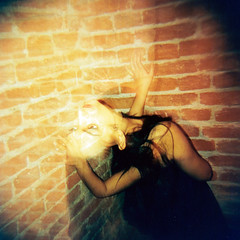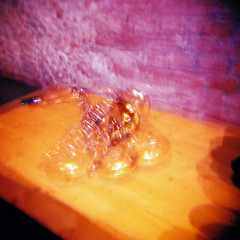Holga medio formato - Amsterdam 2010
The Holga camera was designed by T. M. Lee in 1981, and first appeared outside China in 1982 with its appearance in Hong Kong.[4] At the time, 120 rollfilm in black-and-white was the most widely available film in mainland China. The Holga was intended to provide an inexpensive mass-market camera for working-class Chinese in order to record family portraits and events.[5] However, the rapid adoption of the 35mm film format due to new foreign camera and film imports virtually eliminated the consumer market for 120 rollfilm in China.[6] Seeking new markets, the manufacturer sought to distribute the Holga outside mainland China.
Within a few years after the Holga's introduction to foreign markets, some photographers began using the Holga for its surrealistic, impressionistic scenes for landscape, still life, portrait, and especially, street photography. These owners prized the Holga for its lack of precision, light leaks, and inexpensive qualities, which forced the photographer to concentrate on innovation and creative vision in place of increasingly expensive camera technology.[7] In this respect, the Holga became the successor to the Diana and other toy cameras previously used in such work. A Holga photograph by David Burnett of former vice-president Al Gore during a campaign appearance earned a top prize in a 2001 White House News Photographers' Association Eyes of History award ceremony.[3]
Recently the Holga has experienced renewed consumer interest outside China due to the increasing popularity of toy cameras, and a continuing counterculture response to the increasing complexity of modern cameras.[8]
mercoledì 22 dicembre 2010
lunedì 20 dicembre 2010
Mokum 01b 2010
A city that I love photographed with a Holga, the most unpredictable film camera in the world.
Una città che adoro fotografata con una Holga la fotocamera a pellicola più imprevedibile del mondo.
Una città che adoro fotografata con una Holga la fotocamera a pellicola più imprevedibile del mondo.
11/09 Barètto
Cross processing (sometimes abbreviated to Xpro) is the procedure of deliberately processing photographic film in a chemical solution intended for a different type of film. The effect was discovered independently by many different photographers often by mistake in the days of C-22 and E-4. The process is seen most often in fashion advertising and band photography, and in more recent years has become associated with the Lo-fi photography movement.[citation needed]
Cross processing usually involves one of the two following methods:[citation needed]
* Processing positive color reversal film in C-41 chemicals, resulting in a negative image on a colorless base
* Processing negative color print film in E-6 chemicals, resulting in a positive image but with the orange base of a normally processed color negative
Traditionally, cross processing color slide film in C-41 process chemicals is most common. Some commercial-level photography/darkroom merchants will perform this developing process. However, cross processing can take place in many other forms, such as negative color print film and/or positive color reversal film in a black and white developer.
Other interesting effects can be obtained by bleaching color films processed in black and white chemistry using an hydrochloric acid dichromate mixture or using potassium triiodide (KI3) solution. If these bleached films are then re-exposed to light and re-processed in their intended color chemistry, subtle, relatively low contrast, pastel effects are obtained[citation needed].
Color cross processed photographs are often characterized by unnatural colors and high contrast. The results of cross processing differ from case to case, as the results are determined by many factors such as the make and type of the film used, the amount of light exposed onto the film and the chemical used to develop the film.
Cross processing effects can be simulated in digital photography by a number of techniques involving the manipulation of contrast/brightness, hue/saturation and curves in image editors such as Adobe Photoshop or GIMP; however, they lack the unpredictable nature of regular cross processed images. Some programs, such as online photo editor Picnik even have a cross process function.
Cross processing usually involves one of the two following methods:[citation needed]
* Processing positive color reversal film in C-41 chemicals, resulting in a negative image on a colorless base
* Processing negative color print film in E-6 chemicals, resulting in a positive image but with the orange base of a normally processed color negative
Traditionally, cross processing color slide film in C-41 process chemicals is most common. Some commercial-level photography/darkroom merchants will perform this developing process. However, cross processing can take place in many other forms, such as negative color print film and/or positive color reversal film in a black and white developer.
Other interesting effects can be obtained by bleaching color films processed in black and white chemistry using an hydrochloric acid dichromate mixture or using potassium triiodide (KI3) solution. If these bleached films are then re-exposed to light and re-processed in their intended color chemistry, subtle, relatively low contrast, pastel effects are obtained[citation needed].
Color cross processed photographs are often characterized by unnatural colors and high contrast. The results of cross processing differ from case to case, as the results are determined by many factors such as the make and type of the film used, the amount of light exposed onto the film and the chemical used to develop the film.
Cross processing effects can be simulated in digital photography by a number of techniques involving the manipulation of contrast/brightness, hue/saturation and curves in image editors such as Adobe Photoshop or GIMP; however, they lack the unpredictable nature of regular cross processed images. Some programs, such as online photo editor Picnik even have a cross process function.
domenica 19 dicembre 2010
Iscriviti a:
Post (Atom)




